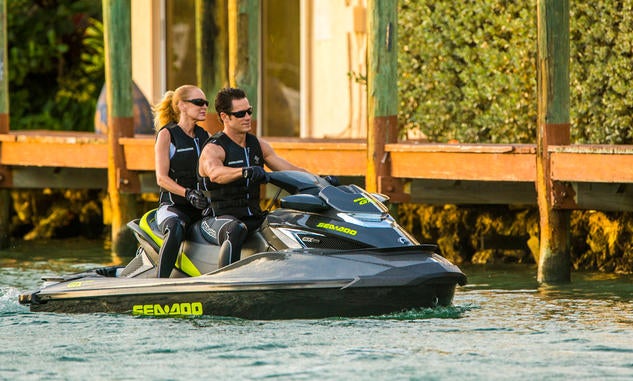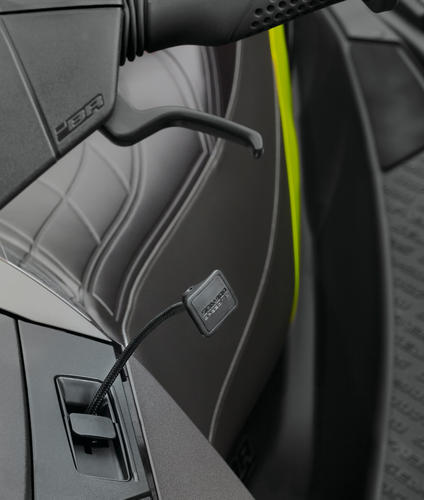2015 Sea-Doo GTX Limited iS 260 Review
Luxury craft targeted at high-end PWC buyer
A particular Sea-Doo marketing rep has long used Richard Branson as the target buyer for the brand’s GTX Limited iS 260. The description fits. No, you don’t need to own an airline or be ridiculously wealthy to afford one, but the Limited is certainly targeted at the high-end PWC buyer. But while it costs a lot, it delivers a lot as well, including literally every one of the brand’s marquee technologies.
What makes the whole package ultimately work, however, is that the boat that lies below all the bling…is pretty darn good on its own.
Rough Water, Smooth Ride
 While the Sea-Doo GTX Limited iS 260 is loaded with new technology and amenities, at its heart is a very capable and fun to ride boat.
While the Sea-Doo GTX Limited iS 260 is loaded with new technology and amenities, at its heart is a very capable and fun to ride boat.The Limited’s most compelling trait is clearly its intelligent suspension. The key is the separation of the rider interface – the saddle, footwells, handlebars and indeed much of the upper deck – from the hull below. Essentially, the craft is divided into two parts, one which rides over the rough waves below, and the other that is cushioned from that chop by the suspension that links the two.
That suspension consists of twin arms, fore and aft, and a center-located spring and shock absorber that allow just shy of 6 inches of travel between the two primary components. When a rider starts the craft, the onboard computer adjusts that spring’s tension based on the load it detects in the saddle. That automatically chosen setting can be overridden manually should the rider prefer a stiffer or softer ride.
COMPARISON: Read our review of the 2015 Sea-Doo GTX Limited 215
To be fair, you still feel the jarring of a rough ride in the seat, but it’s a softer, more cushioned jolt than a rider is used to, as the upper rider area compresses into the hull to absorb a good deal of the shock. I’ve argued before that it’s a feeling that’s probably better for the passengers, who don’t have the advantage of the handlebars to hold onto, and often can’t anticipate the jolts awaiting in the waves ahead. Suspension also lessens the fatigue during a longer ride, keeping the crew aboard fresher.
 This is an internal look at how the suspension in the GTX Limited iS 260 operates.
This is an internal look at how the suspension in the GTX Limited iS 260 operates.In a less obvious way, suspension also helps the Limited’s handling. Like the HX and XP that preceded it, the iS 260 allows the seat to compress and dip lower in a tight turn, lowering the center of gravity. That’s a feature a rider can use when driving the craft through an aggressive corner.
All The Technology
The other notable technological advancements on the Limited iS 260 are ones that are more familiar to enthusiasts thanks to their proliferation throughout the line.
Intelligent Brake & Reverse (iBR) is arguably the most useful. The system introduced braking to the personal watercraft industry by using the reverse bucket and a spoiler to essentially drop into the flow of water exiting the pump. The apparatus acts almost like a drag chute, rapidly slowing the craft’s momentum as the onboard computer simultaneously cuts thrust at the pump. As the craft slows, thrust is then reapplied, but now bounces off that bucket to provide further stopping power. Braking at high speed can be abrupt; you’ll need to hold on and shift your weight back to counter it. But the computer limits the thrust to 3500 rpm, meaning you won’t get thrown over the front old-school-style. In little time a rider will master the system and come to use it without second thought.
COMPARISON: Read our review of the 2014 Kawasaki Jet Ski Ultra 310LX
Stopping power is undoubtedly useful, but the side benefits of iBR may actually steal the show. Thanks to iBR, the Limited starts up in a neutral mode, avoiding the sudden thrust that most PWC experience upon hitting the start button. The rider can then shift casually into forward or reverse, and return to neutral, with opposing levers. It’s an intuitive solution that keeps both hands on the handlebars and eyes on the water.
 Docking and riding in tight spaces is much easier thanks to the iBR system.
Docking and riding in tight spaces is much easier thanks to the iBR system.Electronic throttle also makes possible unique acceleration profiles. The full force of the engine is available in Sport mode, which features an aggressive acceleration curve. A more governed response comes in Touring mode, which makes the curve more gentle. An ECO setting also allows the computer to change the power curve to achieve best fuel conservation.
Naturally, electronic throttle also makes possible cruise control, great for touring and watersports use, and no-wake mode, which holds speed around 5 mph and requires no throttle input for extended low-speed zones.
Solid Foundation
Ultimately, however, no amount of tech can overshadow a PWC’s primary goal of plain-and-simple fun. And here, the Limited iS 260 benefits from the building blocks of the entire GTX lineup.
 The craft’s deep-V hull excels when the water gets rough.
The craft’s deep-V hull excels when the water gets rough.The hull is the same that carries the rest of the GTX line. It’s a deep-V that excels in rough water, delivering a forgiving, predictable ride that inspires a great deal of confidence in the driver and is ready for nearly any water condition. A step in the hull is a nod to boosting performance. Internal ribs increase the rigidity and enhance the solid feel. Enhancing the ride is a quick-response electronic trim (part of the Limited package), which pivots the nozzle up or down to adjust running angle. Lower the bow to put more hull in the water and you’ll increase the craft’s snappy reflexes. Raise that bow and take more hull out of the water and you’ll improve top-end speed. Favored settings can be preset, and then quickly reached without requiring a glance at the display.
COMPARISON: Read our review of the 2015 Yamaha FX Cruiser SVHO
Making the best of that hull’s handling performance is Sea-Doo’s highest horsepower engine, a 1,494cc mill paired with the requisite supercharger and intercooler combo. Horsepower ratings no longer get reported (and Sea-Doo has always taken advantage of marketing allowances that inflate those very ratings), but it’s relatively close to what’s advertised in the name. The way Sea-Doo uses it, that’s plenty of power to push the craft quickly onto plane, and easily moves the craft to the 65 mph mark. In good conditions and with a light load aboard, expect to reach 67 mph before the electronic governor kicks in.
Exclusivity
As to the remaining features that make the Limited what it is, they’re a mix of high-end extras and familiar Sea-Doo standards. Limited features include a custom storage and trailering cover, glovebox organizer, safety kit, dry bag, retractable dock lines, depthfinder, and exclusive coloration. The existing Sea-Doo features include the brand’s dual speed-governing, theft-prevention lanyard system (now improved with a radio-frequency connection), removable watertight storage bin, tilt steering, plush touring-style saddle, hinged seat, and tilt handlebars that cleverly pivot the info display gauges in unison with the bars. One area where the Limited comes up short is in terms of storage capacity. The suspension design allows for only 16 gallons of storage space, which is significantly smaller than any competitive craft.
Yes, all these features – standard and Limited – combine to make the GTX Limited iS 260 one of the expensive craft on the market. But they also combine to make it one of the most fully featured most exclusive watercraft you’ll find in your dealer’s showroom.
And judging by the Branson comment, that’s perfectly fine with Sea-Doo.
| 2015 Sea-Doo GTX Limited iS 260 Specs | |
| Length | 139.2 inches |
| Beam | 48.2 inches |
| Curb Weight | 1030 lbs |
| Engine | Three-cylinder EFI, Supercharged/Intercooled |
| Displacement | 1,494 cc |
| Bore and Stroke | 100 mm x 63.4 mm |
| Compression Ratio | 8.4:1 |
| Fuel Capacity | 18.6 gal. |
| Combined Stowage Capacity | 16.4 gal. |
| Colors | Anthracite Grey & Manta Green |
| Price | $17,299 |
Get PersonalWatercraft.com in your Inbox!
Like PersonalWatercraft.com on Facebook
Comments
Most Popular

2025 Yamaha JetBlaster PRO 2-Up Review

2024 Kawasaki Jet Ski STX 160X Review

Remembering the Sea-Doo XP

Whatever Happened to the Wetbike?

2025 Yamaha JetBlaster Review













 Your Privacy Choices
Your Privacy Choices